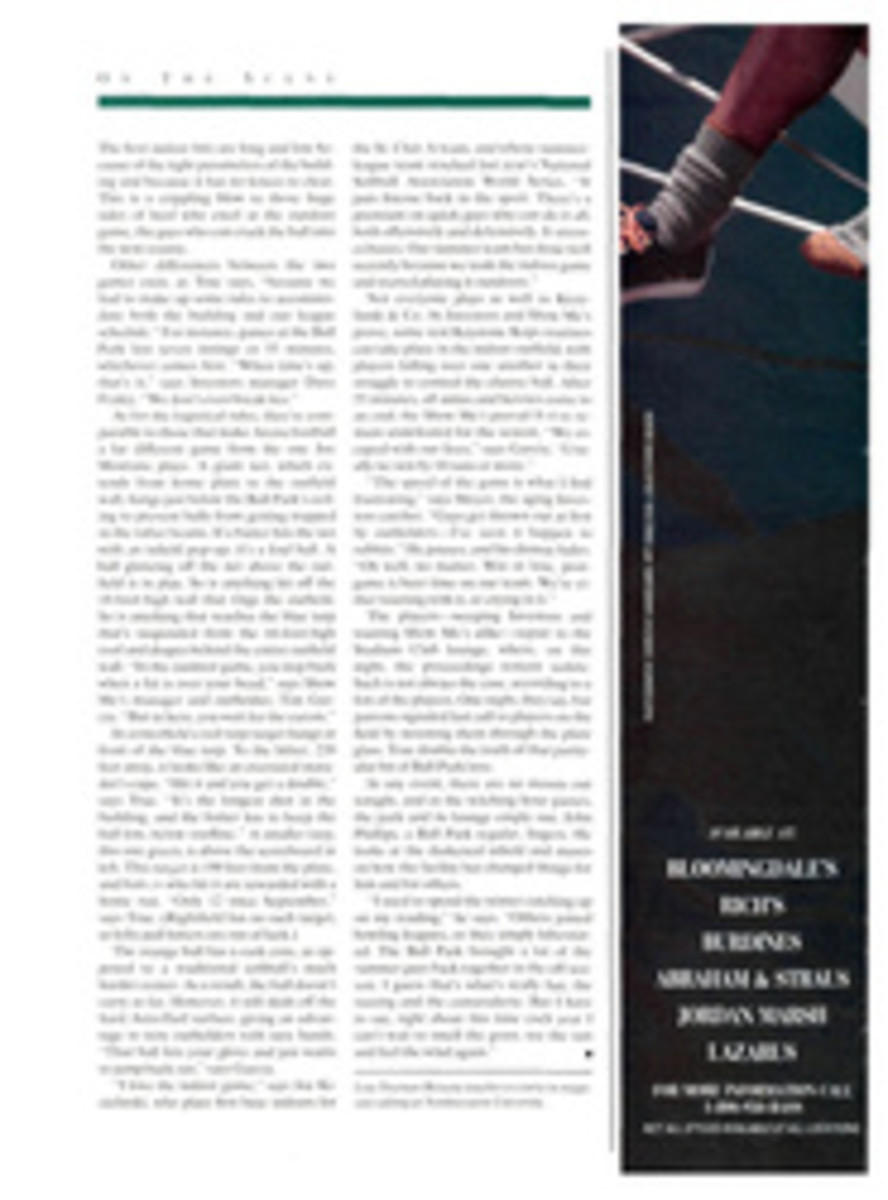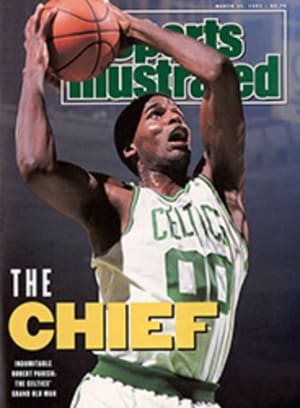
A Lesson from a Legend
Even at midnight, Carlsbad, Calif., is a golf town. The bellboy asks the whereabouts of my golf bag as the cart putters along narrow paths between floodlit lawns on the way to my room. I point back to the Samsonite and the two tennis rackets rattling on the platform behind us.
"Tennis," I say, weary after a day spent in planes and airports.
Still, I find myself tempted to confess to this bellboy how, 25 years ago, I tore out a picture of The Man from a book on tennis in the high school library. I pinned up the picture over my bed. The Man is in long pants, in full flight, his racket outstretched, his forearm muscles like cables under the skin, his hawk's gaze locked on the prey—a tennis ball not actually in the photograph but vivid in the mind's eye. The photograph embodied qualities that, to my adolescent soul, made The Man spiritually important—qualities shared with Chuck Berry, President Kennedy and Marilyn Monroe, all of whom also graced my wall. Even then the book was old and The Man had all but concluded his tournament career, but unlike other objects of my idolatry who had dropped from sight, he retained his spot on the wall.
I did not confess all that to the bellboy. Instead, I asked him whether The Man still teaches. Or is he just a come-on for the hotel brochure's sake—like the impossibly beautiful model photographed on the edge of a steaming whirlpool.
"He still teaches," said the bellboy. ''He's always there."
Next morning at 7:30 I call the desk and say I want a tennis lesson. They check The Man's schedule and say, possibly. Yes, possibly even today. They will check with The Man. He will call me.
Fifteen minutes later the phone rings as I sip coffee and read the calorie counts printed on the breakfast menu. The Man is on the line. He pronounces my name carefully. I can take you at 12 o'clock," he says. "You want a half-hour?"
"One hour," I reply.
"O.K. You know it is $100."
"Yes, sir." The "sir" comes naturally.
I check in early at the pro shop. I hear him talking in an office somewhere in the back. I watch some doubles and after a long time—I am very early—he comes out. The same voice I heard on my room phone—raspy and faintly Latin accented—asks someone sitting near me if he is the one waiting for a lesson. "It's me," I say, standing and turning to face The Man.
He is much shorter than I imagined and absurdly pigeon-toed. After a handshake he takes off in a brisk crab-walk, his trunk swaying from side to side, two rackets clutched in the crook of his arm, head held high despite the stoop of his back that robs him of more inches. He wears white cotton warm-up pants and a large, predominantly white tennis jacket-zipped with its collar upturned—in which he floats as if in a life vest. His tennis shoes are high-topped and richly padded. The laces are very loose and yet the tongue of the shoe bulges out. I picture the foot, curled inward, all the weight on its outer edge as he makes his pigeon-toed way forward.
When we are at the court, The Man says, "Show me your grips."
I show him my forehand—extreme Western. He makes a sucking sound between his teeth and I think I see a grimace. It is difficult to tell; the dark sun-furrows etched in his face give him an almost permanent scowl. "Ayy, Western grip. Now show me the backhand."
Again a contortion of The Man's face suggests he would prefer the grip were more like that of a Continental forehand.
"Can you slice the forehand to approach the net?"
"...Yes."
"Good." He shows some relief; perhaps I am salvageable.
"Listen to me," The Man says, coming up so close that I tense. "Listen to what I am going to tell you because it is the most important thing about tennis. What's your name? ... Abraham? ... Abraham, listen to me. This is what tennis is all about: The ball must he hit deep, or angled away.... The short ball must be punished outright—or used to attack.... The game is won at the net.
"That's it," he says. He studies me carefully, looking for doubt, disagreement or, perhaps, understanding.
All I feel is a sense of bewilderment. Not that any of this advice—keep it deep, punish the short ball, win at the net—is new. Yet, at this instant, a lifetime of tennis is erased; it is as if I am hearing for the first time how the game is played. The mechanical aspects of hitting the ball, the usual focus of tennis lessons I have taken in the past, suddenly seem banal. This I am hearing now is the philosophy of hitting the ball.
"That's it," he repeats, as if reading my thoughts. "There is nothing else."
I feel a warmth emanate from him. Perhaps The Man senses that a catharsis has occurred in his student. In the depths of the left pupil I also see a hint of a cloudy-white opacity, a reminder of the passage of time.
"We will hit some balls," he says. "Some will be short. Hit them and come in. Hit deep and to the center for now."
We begin to rally. It is a feeling akin to communion as his ball, heavy and deliberate, is met by my racket and propelled back, deep, wobbling eccentrically, revealing a diffidence that diminishes the longer the ball is in play.
He hits a short ball, deliberately. I slice a backhand approach—head down, knees bent, following through deep to the target—and he effortlessly lobs over my left shoulder and into the backhand corner. It is not height that makes it unplayable: The ball is behind me before I even see it.
I go back to the baseline, rally again, approach on a short ball—and the same thing happens. He strikes my approach on the rise—a wonderfully timed half-volley lob. The stroke begins in the misshapen feet and travels up the bowed knees and into the hips that are now magically fluid and supple. The ball is struck well out in front, as if the meeting of it is secondary and of less import than the stroke itself. He holds the follow-through, punctuating the stroke, remaining motionless as the ball rises, spinning in the same axis as its flight, over my left shoulder and into the backhand corner.
"You need to think," he says. "That is what you need to learn. Your strokes are not bad. When you sec me like this [he mimes hitting the ball late] you know it is a short ball. Start coming in at that moment. If you anticipate, you can hit a better approach."
He feeds me short balls and I approach. Unless my approach is deep enough to push him onto the back foot, he meets my return with the lob—each one identical to the one before, arcing over my backhand and into the corner. Each unplayable.
I am now so intent on coming in that when he hits a high ball that lands at the baseline and kicks up, I make an awkward high swing—more an act of self-preservation than a stroke—popping up a short ball. When I look up, he is two feet inside the service box. He slaps the ball with a hint of underspin at a sharp angle cross-court. I hear a thwump! as the shot comes off his racket; his stroke epitomizes the idea of "putting the ball away." I stand lead-footed watching the ball skid low, grazing the inside of the line on its way to the chain link.
"Come here!" he says, slapping the net with his racket edge. "I knew you were going to hit short before you knew. My ball caught you flat on your heels. You had to hit short! Remember, all shots are played at waist high; you should have moved back to hit that shot. Use your head." He makes as if to return to the baseline but thinks better of it and continues: "If the ball is coming this high over the net, where will it bounce?"
"High and deep," I say.
"So...."
"So I must move back," I say.
"And if it comes in low over the net, like this, where will it bounce?"
"Short."
"So...."
"Slice and come in."
"Yes! Now go back and let us try some more. Short ball, come in."
More approaches. My heart pounds, and sweat soaks my T-shirt and forms a V on the front of my tennis shorts. If the approach is not deep, he punishes me—always with the lob.
When I finally hit 10 good approaches he says, "That is what I want! Come here."
I go to the net, grateful for a rest.
He looks around and lowers his voice: "Of all the pros, John is the best," he says, not feeling the need to further identify for me the John he refers to. "For my money he is the best because he knows how to read the short ball and take advantage. That, my friend, is what it is all about. That is the name of the game."
Forty minutes have gone by, most of it spent on the approach shot. In the next few minutes he looks at my other shots. He has me try some volleys. He is only happy when I hit the volley with a racket almost perpendicular to the net, angling the ball acutely and with pace.
He looks at my drop volleys. "Drop volleys are only for soft balls and always hit crosscourt," he says. "You can't let the ball drop too low before you hit the drop volley. If you let it drop, your opponent knows you have to hit it up. And so he will be coming in. Unless he is stupid. If he is stupid, you will win anyway."
He looks at my serve, return of serve, lob, overhead and passing shots. He makes only minor comments.
I get the feeling that he is unconcerned, given the nature of our brief lesson, about trying to correct the mechanics of a shot. It is the use of a shot that he dwells on.
When the hour is over I help him pick up balls. He has not broken a sweat under his jacket. We walk back together, me beside him, in stride, in rapture.
In his office I show him a picture of my son that I had brought along in the pocket of the racket cover. My son is four, and he is in a tennis hat pointing at the camera, his dimples irresistible. I ask The Man if he will sign it. Perhaps if he signs it he will somehow convey some of his magic to my son. I don't say this to him.
I see the first smile of the day on that face and a hint of tenderness.
"What's his name?" he asks.
"Steven."
He writes painstakingly, laboriously, as if the only tool those knobby hands are suited for is a racket: To Steven: punish the short ball. Pancho Segura.
Dr. Abraham Verghese was born in '55, when Segura was in the U.S. Pro Championships finals.
TWO ILLUSTRATIONS
JONATHAN ANNAND

